
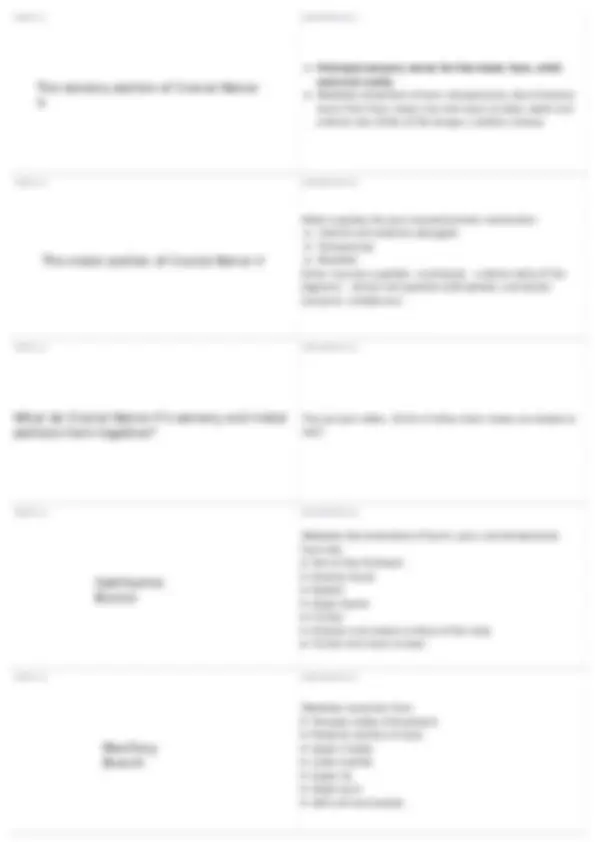
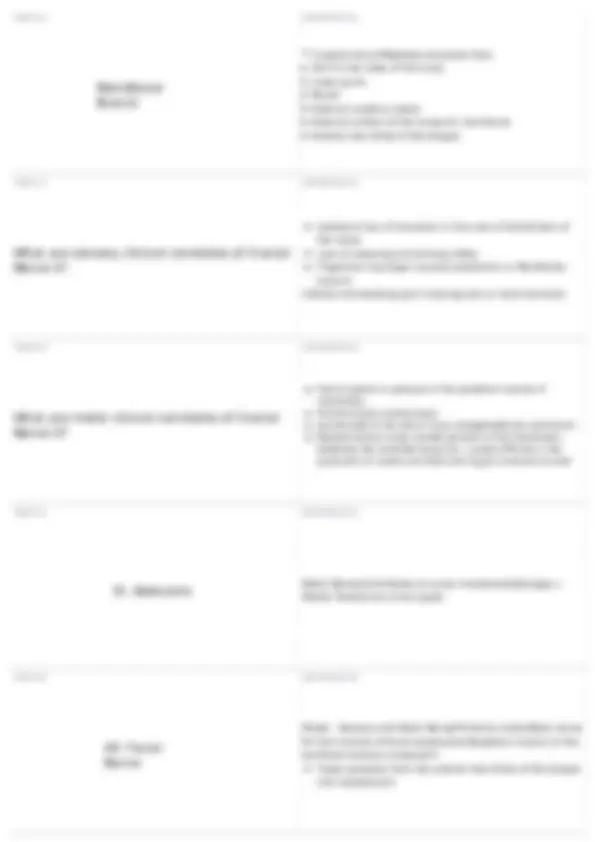
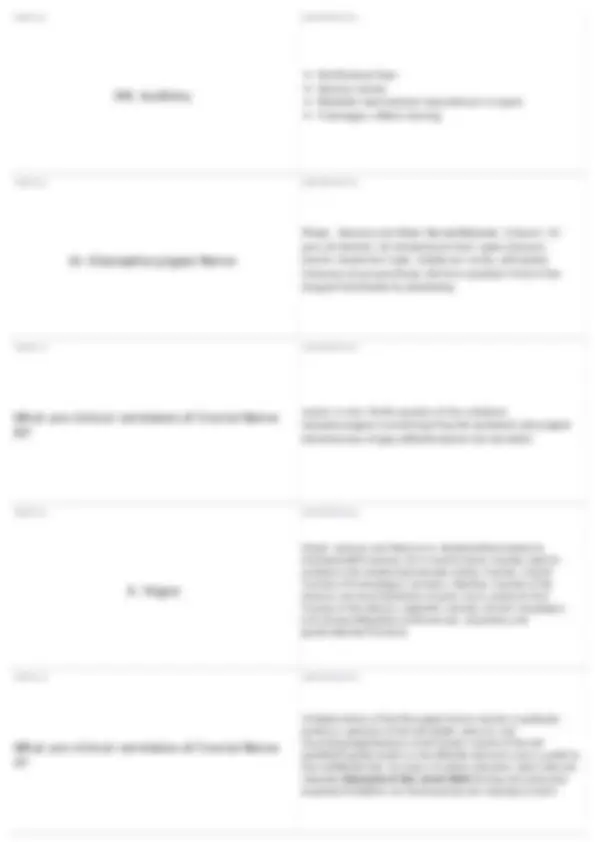
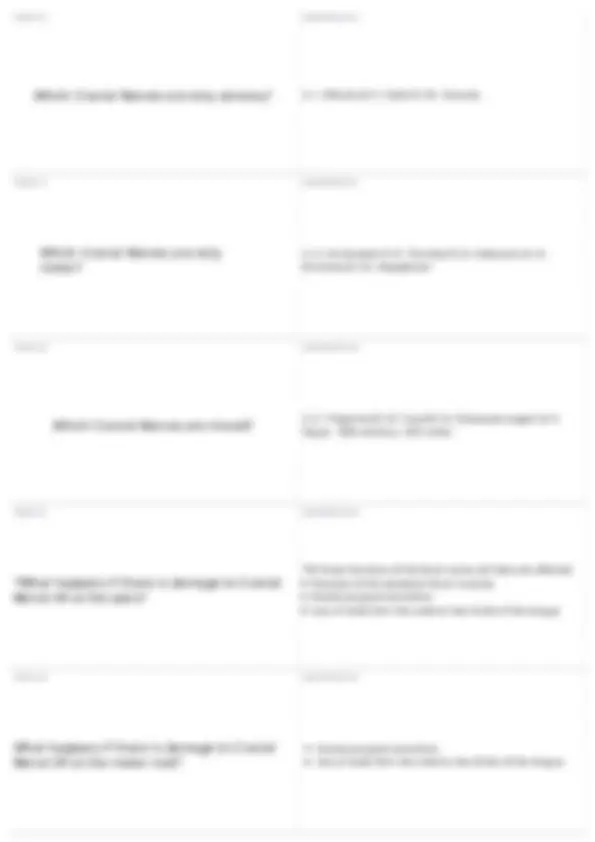
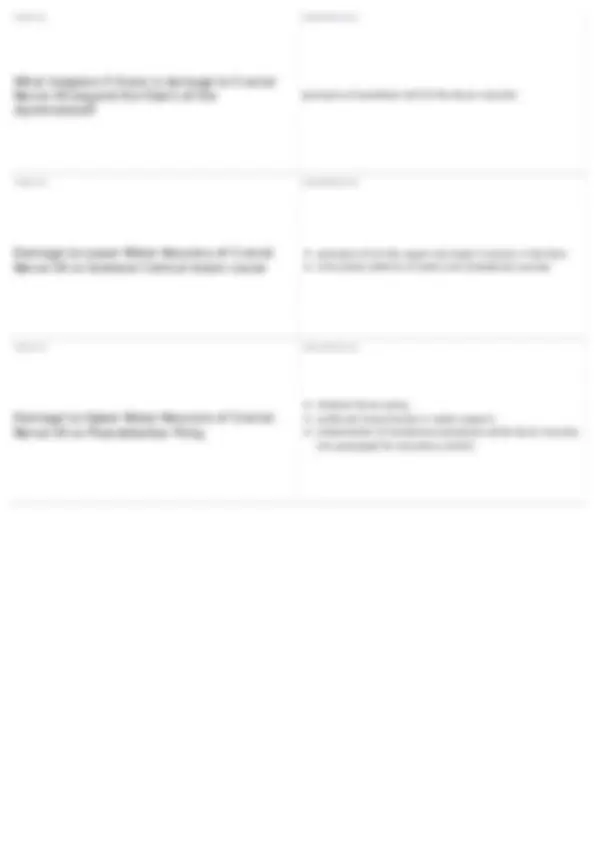


Study with the several resources on Docsity

Earn points by helping other students or get them with a premium plan


Prepare for your exams
Study with the several resources on Docsity

Earn points to download
Earn points by helping other students or get them with a premium plan
Community
Ask the community for help and clear up your study doubts
Discover the best universities in your country according to Docsity users
Free resources
Download our free guides on studying techniques, anxiety management strategies, and thesis advice from Docsity tutors
An in-depth exploration of the twelve cranial nerves, their functions, and the clinical correlates associated with each nerve. Both sensory and motor functions, including the order and names of the nerves, their sensory and motor branches, and the clinical symptoms of damage to each nerve.
What you will learn
Typology: Quizzes
1 / 9

This page cannot be seen from the preview
Don't miss anything!






DEFINITION 2 I On.Olfactory XI At AccessoryII Old Optic XII Hops. HypoglossalIII Olympus OculomotorIV ToweringTrochlearV Tops. *TrigeminalVI A AbducensVII Fin FacialVIII And. Auditory/Vestibulocochlear IX GermanGlossopharyngeal X Vended Vagus TERM 3
DEFINITION 3 Sensory Nerves Ages 60-65, begin to lose sense of smell Anosmia Hyperosmia Hyposmia Bilateral lesions have a drastic effect on sense of smell *smell directly related to tastes, so older people eat less TERM 4
DEFINITION 4 Inability to perceive smell, odor. Can also affect loss of taste TERM 5
DEFINITION 5 Abnormally acute sense of smell; heightened sense of smell
Decreased olfactory sensation (sense of smell) TERM 7
DEFINITION 7 Sensory Selected visual field loss Lesion of entire optic nerve would result in complete blindness *she is not very interested in this. TERM 8
DEFINITION 8 Motor Nerves Traumatic Brain Injury (TBI) Ptosis (drooping eye lids) Strabismus (cross-eyed; lazy eye), affects peripheral vision, genetic TERM 9
DEFINITION 9 Motor NervesIf damaged, weakness or paralysis of the superior oblique muscle (eye) Diplopia (double vision) TERM 10
DEFINITION 10 Mixed - sensory and motor nervesHas three sensory branches: Ophthalmic Maxillary Mandibular
** Largest branchMediates sensation from Skin on the sides of the scalp Lower gums Mouth External auditory meats External surface of the tympanic membrane Anterior two thirds of the tongue TERM 17
DEFINITION 17 Ipsilateral loss of sensation in the area of distribution of the nerve Loss of sneezing and blinking reflex Trigeminal neuralgia (usually ophthalmic or Mandibular branch) Intense and stabbing pain involving one or more branches TERM 18
DEFINITION 18 Flaccid paresis or paralysis of the ipsilateral muscles of mastication Muscle atrophy (waste away) Jaw deviates to the side of injury (exaggerated jaw protrusion) Bilateral lesions cause marked paralysis of the mastication, bilaterally the mandible hangs low - causes difficulty in the production of vowels and labial and lingual consonant sounds TERM 19
DEFINITION 19 Motor NervesContributes to ocular movementsDamage = Medial Strabismus (cross eyed) TERM 20
DEFINITION 20 Mixed - Sensory and Motor NervesPrimarily motorMotor nerve for the muscles of facial expressionsStapedius muscle (in the ear)Small sensory component Taste sensation from the anterior two thirds of the tongue and nasopharynx
Vestibulocochlear Sensory nerves Mediates head position (equilibrium) in space If damages, affects hearing TERM 22
DEFINITION 22 Mixed - Sensory and Motor NervesMediates: (1)touch, (2) pain,(3) tension, (4) temperature from upper pharynx, tonsils, Eustachian tube, middle ear cavity, soft palate (intraoral structures)Taste info from posterior third of the tongue!Contributes to swallowing TERM 23
DEFINITION 23 Lesion is rare. Partial paresis of the unilateral stylopharyngeal muscleImpairing the ipsilateral pharyngeal elevationLoss of gag reflexExcessive oral secretion TERM 24
DEFINITION 24 Mixed - Sensory and MotorA.K.A. WandererMost extensive distribution90% sensory 10 % motorControls muscles used for probation and swallowingInnervate cardiac muscles, smooth muscles of th esophagus, stomach, intestine, muscles of the pharynx and larynxSensation of paint, touch, pressure from mucosa of the pharynx, epiglottis, trachea, bronchi, esophagus and stomachRegulates cardiovascular, respiratory and gastrointestinal functions TERM 25
DEFINITION 25 Unilateral lesion of the Pharyngeal branch results in ipsilateral paresis or paralysis of the soft palate, pharynx, and larynxDysphagiaParalysis of the levator muscle of the soft palateSoft palate lowers on the affected side and uvula is pulled to the unaffected side. Coronary circulation disorders, heart rate and relaxation Paralysis of the vocal folds Choking and pulmonary aspirationIf bilateral, will have aphonia and inspiratory stridor
Mid brain lesion Primarily affects oculomotor nerve Contralateral hemiplegia Ipsilateral ocular paralysis Ptosis (drooping eyelid) Pupil dilation Lateral deviation of the ipsilateral eye TERM 32
DEFINITION 32 Lower pons lesion Facial nerve Descending motor fibers Marked contralateral hemiplegia Ipsilateral facial paralysis Motor speech disorder TERM 33
DEFINITION 33 Bilateral pons lesion Interrupts all the descending corticospinal fibers Quadriplegia Loss of all motor speech functions Patient remains fully awake and can only blink TBI *Brain is fine, but body is locked in. TERM 34
DEFINITION 34 Lateral medulla lesion Loss of pain sensation from the ipsilateral face and contralateral side of the body Limited motor and speech movements of the pharynx, larynx, and soft palate TERM 35
DEFINITION 35 Medial Medulla Lesion Contralateral hemiplegia, contralateral loss of proprioception and vibration Ipsilateral lingual paralysis
DEFINITION 37
DEFINITION 38
DEFINITION 39 *All three functions of the facial nerve will likely be affected. Paralysis of the ipsilateral facial muscles Excessive gland secretions Loss of taste from the anterior two thirds of the tongue TERM 40
DEFINITION 40 Excessive gland secretions loss of taste from the anterior two thirds of the tongue